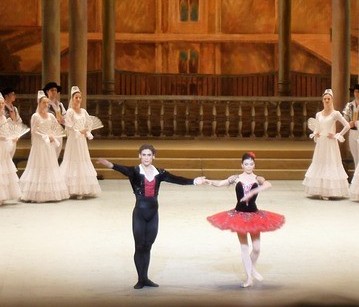I was teaching for another teacher the other day, and when the class was completed the pupils rushed off to get their clothes. I shouted at them ‘girls where is your curtsey.’ They looked at me awkwardly and then half-heartedly made there way back onto the floor and did a terrible attempt at a reverence in ballet.
I think that over the years, teachers have forgotten what an important thing a simple thing like a reverence in ballet can be. Not only is it a way to acknowledge each other after a class and show respect, but also a way of thanking the teacher for teaching them, and the teacher thanking the pupils for working hard.
Has etiquette totally flown out of the window in these modern times?
Demonstration On How To Do A Reverence In Ballet
Everyone has their own way of doing a reverence in ballet, and the reverence can vary from a simple port de bras and curtsey to a more elaborate one as seen below.
Why Do We Do A Reverence In Ballet?
 In the picture on the left, you see two dancers who are doing a reverence in ballet after they have completed their show.
In the picture on the left, you see two dancers who are doing a reverence in ballet after they have completed their show.
This is customary in any dance performance that you go and see and it is the dancers way of acknowledging the audience and vice versa.
In class, especially from the teenagers, I get very sloppy curtsey’s at the end of class, and I think I need to start putting my foot down here, as not only is it disrespectful to themselves and me, but it teaches them nothing about how to handle themselves after doing a performance on stage.
This can make all the difference to how the dancer presents herself on stage. Will it be done with confidence or will it look like she is self-conscious?
If you as a teacher have taken care to correct your students during class, then they should carry that same technique right through to the reverence. Don’t be frightened to make them do their reverence properly with good technique at the end of class.
The reverence in ballet is such a small task that is done at the end of the class. The ladies curtsey and the gentlemen bow and then everyone applauds before going away.
Although the reverence in ballet is a small task, it is so significant as it honours the process and closes the class with grace.
The reverence is a way of showing respect to the struggles, both mental and emotional, the dancer has fought during the class and wraps it all up with a healthy dose of dignity.
So no matter what happened in class the reverence in ballet says you did well, are still standing and should be proud of what you accomplished.
The reverence in ballet is so small a part of the class but so significant.
How To Do A Reverence In Ballet
You can view the video above for a good demonstration of a reverence.
“A reverence at the end of a ballet class is a combination that is done out of respect for the art, a sort of “cap” that both thanks to the teacher (and pianist if there is one) and honours the traditions of this beautiful and classical art form.
The reverence combination will usually include port de bras in different positions, curtsies for the ballerinas, and bows for the male dancers, all done to beautiful adagio music. It is fitting because ballet is an art, not a sport where the team is given a few high-fives as they chug water running off the field. While there is nothing wrong with high-fives the reverence at the end of a ballet class is much more fitting to an art form and is almost like the final sentence of an eloquently spoken speech.”
So teachers, even if your teens are giving you attitude, just do it and they will come around. The more they do it the more they will understand why, so all I can say is just keep teaching reverence in ballet teachers.
Here you can read more about the elements of dance.

I would ask that rèvérences should always include the acknowledgement of the PIANIST’S contribution to the CLASS and NOT just as an ‘afterthought’! Otherwise, undertake the class without music ?, recorded or live. This reduces (only slightly) the advent of Narcissism in both the teacher and the students. Thank you. ? ? ✨
Thanks for bringing this to our attention Alasdair. The Pianist is a very important part of the class and should be acknowledged as such. It is also only good manners and pupils (and teachers) need to work on this aspect of their training.